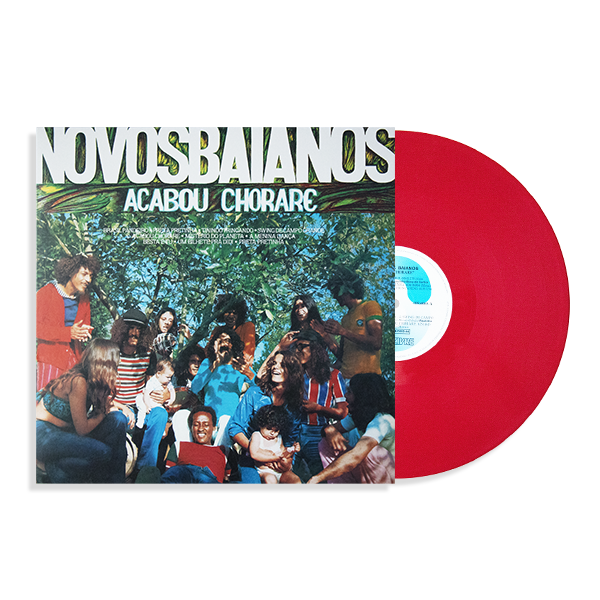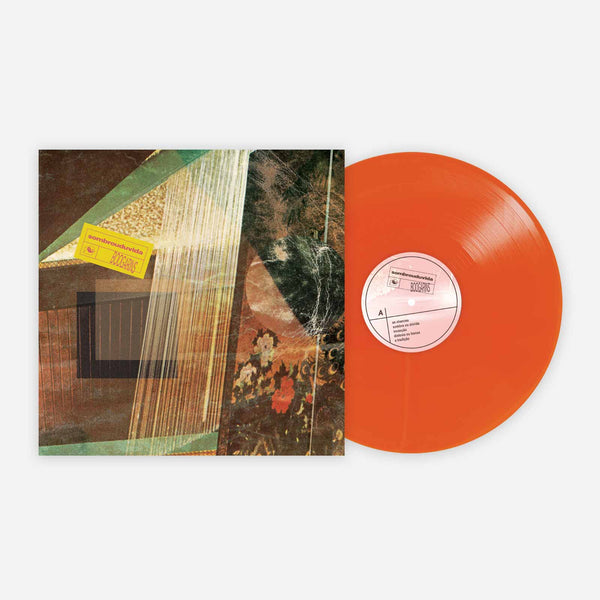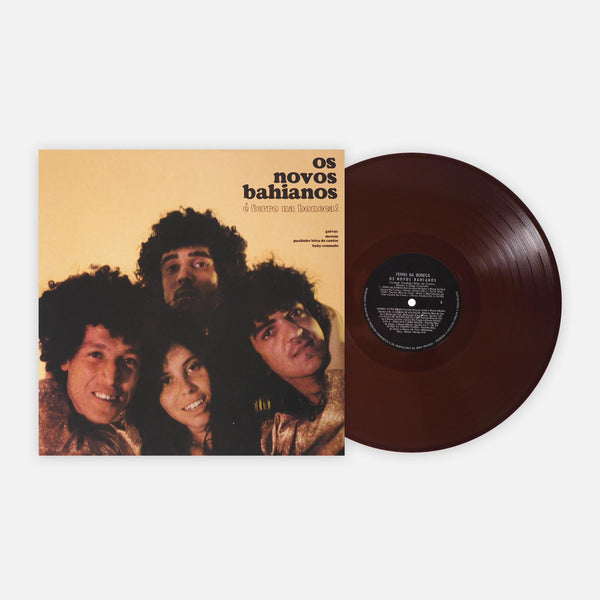7月、Vinyl Me, Please Essentials のメンバーは、Jorge Ben の África Brasil の新しいカラーバージョンの再発を受け取ります。なぜこのアルバムを選んだのかについてはこちらをクリックして確認でき、下記ではアルバムの新しいライナーノートを読むことができます。
Like Bob Dylan leaving the folk scene behind, strapping on an electric guitar, and assaulting the crowd at Newport with a set of searing electric blues-rock a decade earlier, Jorge Ben’s África Brasil sent shockwaves through his loyal audience. On África Brasil, Ben abandoned his signature swinging, acoustic “samba-soul” or “samba-rock” style, switched to an electric guitar, and transformed his approach, delivering a set of tunes that melded the central elements of his approach to samba with hard-driving funk grooves. In addition to the stylistic change, Ben’s lyrics exhibited a heightened sense of black pride.
África Brasil shows that Ben was very much in tune with the evolving scene in black America. The emergence of black nationalism and the funk style went hand in hand in the United States during the late 1960s and early 1970s. Many young African-American activists rejected the “Freedom Now” integration agenda and threw support behind a new concept — “Black Power,” which represented a demand for self-determination in terms of politics, economics, education, and culture, and called for self-definition as African people linked to the freedom struggles throughout the Diaspora. Inspired by the mandate for Black Power, a groundswell of African-American artists came together to form the Black Arts Movement, a demand for the use of black images, symbols, forms, and cultural figures to create art, and a black way of judging art.
A remembering of African heritage and the connection of African people throughout the world, Pan-Africanism was central to this self-definition. These concepts found their way into soul music that had dominated black record charts during the ’60s, perhaps most crucially expressed in 1968 when James Brown released “Say It Loud, I’m Black and I’m Proud.” This shift is evident in the music of Curtis Mayfield, as Civil Rights anthems like “People Get Ready” and “Keep On Pushing” gave way to black nationalistic declarations like “This Is My Country” and “We People Who Are Darker Than Blue,” or even more pointedly in Sly & the Family Stone’s recasting of “Thank You (Falettinme Be Mice Elf Agin)”as “Thank You For Talking To Me Africa.” The influence is also evident at Stax Records in Memphis, where Isaac Hayes released the orchestrated funk opus Black Moses, and the label organized a “Black Woodstock” with the Wattstax festival in Los Angeles. Eventually, these themes would be adopted by artists from the Motown crossover hit-making machine, with songs like Stevie Wonder’s “Black Man” and Marvin Gaye’s “Inner City Blues (Make Me Wanna Holler).”
With Brown and Sly Stone at the forefront, R&B evolved into this new style dubbed “funk,” with its heavy bottom end and polyrhythmic emphasis on the downbeat — the first beat in a four-bar measure (celebrated by Brown as “The One”), and all the instruments in the band bouncing off each other and driving the groove. The approach was further refined in New Orleans, as producer/songwriter Allen Toussaint recruited the Meters as a house rhythm section at his Sea-Saint Studios to generate ferocious funk groove performances, including their own “Africa.” Brown’s rhythmic innovations had Pan-African implications in the music of Fela Kuti, the Nigerian multi-instrumentalist, singer, and political firebrand. Fela spent time in Los Angeles in 1969 and was turned on to the concepts of Black Power through a relationship with a Black Panther Party member. He took this new political consciousness back to Lagos and melded Brown’s funk innovations to traditional African rhythms into what was called Afrobeat. The funky grooves crafted by Brown, Sly, Mayfield, Wonder, Hayes, the Meters, and Fela, along with this new black consciousness, are deeply interwoven into Ben’s sambas on África Brasil.
The roots of samba in Brazil reach deep into the remembered cultural and artistic traditions of the descendants of enslaved Africans. More Africans were transported to Brazil than any other country in the Americas. Founded in 1549, Salvador da Bahia was the first capital of the Portuguese colonies, and was the entrance point for a vast number of African people into Brazil. “Samba-de-roda” was an African-based polyrhythmic percussion-driven dance music that thrived in Bahia’s Recôncavo — the plantation region around the bay over which Salvador presides — and was carried to Rio de Janeiro as Bahians gained mobility after Emancipation in 1888. Samba flourished in Rio and, like jazz and blues, is a genre that includes a wide array of stylistic variations that evolved over the first half of the 20th century, ranging from the large percussion-driven Carnaval parade schools of “samba-enredo” to the slower, softer emphasis on melody and lyrics of “samba-canção.” During the 1950s, the melding of “samba-canção” with the “cool” jazz of American artists like Chet Baker, Charlie Byrd, Miles Davis, and Stan Getz produced the sounds of Bossa Nova (New Beat), which generated an international craze for Brazilian music. And, it was on this scene, in the early 1960s, that Jorge Ben first made his mark.
Born Jorge Duillo Menezes to a Brazilian dock-worker father and an Ethiopian mother in 1945 in Rio de Janeiro, Ben adopted his mother’s maiden name when he began his musical career, which he changed to Jorge Ben Jor in 1989. Primarily self-taught on the acoustic guitar, he developed a quirky style that emphasized driving rhythmic strumming of the lower strings. Although he dreamed of becoming a football player, he began working in small clubs in Rio and scored a hit with “Mas Que Nada” in 1963. It garnered Ben international renown when Sergio Mendes’ cover soared up the pop charts in 1966, solidifying Ben as a composer whose songs were regularly covered by a wide range of Brazilian and international artists.
The 1960s in Brazil were tumultuous times. After a political coup in 1964, a military dictatorship was in control through the 1970s, and censorship and repression were often directed at musicians who were deemed subversive. The Brazilian music scene itself was just as tumultuous — and gloriously varied and creative. Two major musical movements were at odds. The Música popular brasileira (MPB) was acoustic-based and dedicated to drawing upon traditional Brazil roots as it melded with outside influences like rock, jazz, and pop and often featured sophisticated lyrics. The Joven Guarda (Young Guard) were American and British invasion rock ’n’ roll-oriented. Ben’s distinctive style allowed him to straddle both movements. In 1967, he moved to São Paulo and began drawing upon diverse influences, including blues, rock, soul, jazz, and pop. The move also fostered an association with Gilberto Gil and Caetano Veloso, two Bahian musicians who were central figures in the creation of the Tropicália (or Tropicalismo) movement. Tropicália was an art movement that espoused a “cultural cannibalism,” blending samba and traditional Brazilian forms with a wide array of international influences, including the heady swirl of psychedelic rock. Ben was never strictly a part of the movement, although he certainly interacted with Gil and Veloso and explored similar musical turf, as evidenced on his 1969 album Jorge Ben that features his signature approach to acoustic guitar-driven samba infused with Beatles-esque folk rock and punchy soul music-derived horn sections.
During the early ’70s, Ben released a string of albums that testified to his brilliant creativity. It was during this period that Ben’s embrace of Afro-Brazilian black consciousness began to emerge. The psychedelic-inspired album cover of Jorge Ben features an illustration of Ben wearing broken manacles, and he titled his 1971 album Negro É Lindo (Black Is Beautiful), which, in addition to the title track, featured such tunes as “Cassius Marcelo Clay” (“Soul brother, soul boxer, soul man”). Despite the wide range of influences that Ben was able to meld into his still largely acoustic samba sound, nothing could have prepared listeners for the crunching electric guitar and percolating funk grooves that exploded from África Brasil.
In 1976, Ben collaborated with Gil to release Gil E Jorge, a stripped–down, free-ranging acoustic guitar jam session with the two leaders sparring both vocally and instrumentally. The approach to África Brasil, released later that year, was a total contrast. Ben meticulously crafted a deeply layered and textured recording, interweaving his multi-tracked electric guitar work with deep funk bass lines; a phalanx of percussion players; a horn section; and lead and backup vocals. Many of the tracks prominently feature the cuíca, the distinctive African-derived samba drum which produces a voice-like squeaking sound — thanks to its variable pitched head — amid the roiling electric funk performances, as Ben uses the cuíca as a voice that gives the music an essential Brazilian identity. The album also bears witness to Ben’s all-out embrace of the electric guitar. And the influences from American R&B certainly shine through, as traces of Chuck Berry, Bo Diddley, Jimmy Nolen (from James Brown), Mayfield, and Leo Nocentelli of the Meters surface in the churning mix. Credited as playing “Guitarra solo, Guitarra Centro, Phase Guitar,” Ben constructs complex, interlocking guitar parts, including slashing “chicken-scratch” rhythm work, chunky chords, and stinging single-note blues fills.
While África Brasil is radically different from anything he had previously released, it is still identifiably Jorge Ben, thanks to his signature vocal sound and style. His voice is distinguished by a warm, vibrant huskiness, and he imbues his singing with a wry humor, a soulful ache, and an alluring sensuality. Ben loves to play with the sound of words, and he drives and enlivens a song with a dedication to the repetition of words and non-literal sounds that function like instrumental hooks. On previous recordings, Ben often featured back-up vocalists singing harmony on his seductive melodies, but on África Brasil the emphasis is much more on the push/pull drive of the call and response approach that was so integral to Fela’s Afrobeat.
While the dedication to Pan-Africanism is undeniable on many tunes, Ben also continues to explore familiar themes with his often deceptively simple lyrics: his fanaticism for football and a fascination with alchemy and myths. The stylistic shift to funk is further emphasized by Ben’s recasting of four tunes from previous acoustic samba recordings. The album opens with “Ponta de Lança Africano (Umbabarauma)” (“African Spearhead”), a salute to an African soccer player. “Hermes Trismegisto Escreveu” (“Hermes Trismegisto Wrote”) includes the chorus from a previously recorded song about a figure from Egyptian and Greek mythology who wrote on alchemy. More myth and mysticism is apparent in “O Filósofo” (“The Philosopher”). “Meus Filhos, Meu Tesouro” (My Children, My Treasure”) exuberantly proclaims his love for children and their aspirations. Originally recorded in 1964, “O Plebeu” (“The Commoner”) features a poor man confident that his pledge of love to a princess will be fulfilled. “Taj Mahal” (the Indian palace) again looks to a mystical past and is, perhaps, the most familiar track on the album — not because it had been a hit for Ben with one of his multiple previous recordings — but because Rod Stewart copped its infectious hook and transformed it into “Do Ya Think I’m Sexy” (and lost a plagiarism suit for doing so). With “Xica da Silva,” Ben combines his interest in myth and legend with Afro-Brazilian heritage as he lauds a historical black woman (he consistently hammers home “a negra”), who transcended enslavement, married a wealthy white planter, and became mistress of the manor. He crafts his own myth with “A História de Jorge” (“George’s Story”), a song about a young boy who learns to fly. Football heroics are the subject of “Camisa 10 da Gávea” (Gavea’s Jersey No. 10). And, the program concludes with two songs of an Afro-Brazilian hero: “Cavaleiro do Cavalo Imaculado” (“Knight of the Immaculate White Horse”) and the title track “África Brasil (Zumbi),” re-worked from a folksy singalong to gruff defiant anthem, a paean to the warrior leader of the Palmares, Afro-Brazilians who escaped enslavement and fought their oppressors.
África Brasil was not a major seller for Ben when it was released and ultimately began to gain its reputation as one of the all-time great Brazilian albums after David Byrne included the opening track on his 1989 compilation Beleza Tropical: Brazil Classics 1. Nevertheless, it is a major milestone in Jorge Ben’s career. Brashly declaring his Afro-Brazilian identity over electric guitar-driven funk grooves, he moved on from the acoustic sambas upon which he had built his reputation, and within the next year, he was in London recording at Island Studios establishing himself as a major figure on the blossoming world music scene.
Robert H. Cataliotti is a professor at Coppin State University, a contributing writer for Living Blues, and the producer/annotator of the Smithsonian Folkways recordings Every Tone A Testimony and Classic Sounds of New Orleans.







